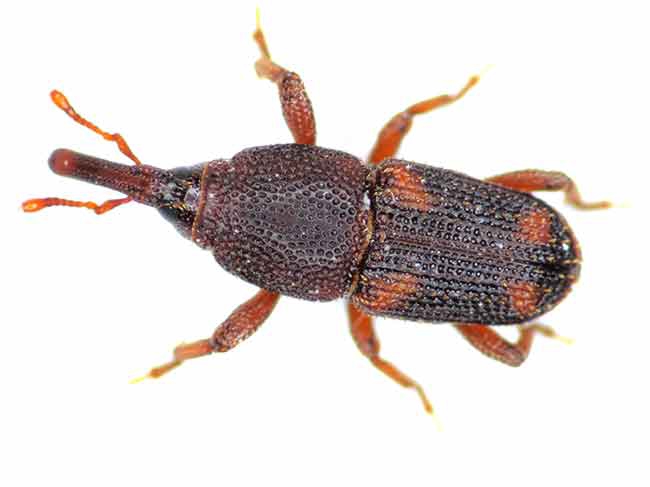
Pantry pests
October 26, 2015
By Alice Sinia
Don’t let common pests spoil your food and damage your reputation
 Weevils are easily identified by the elongated snouts on their heads, a characteristic that also makes them easily distinguishable from other stored product pests. photo credit: fotolia/maggiww
Weevils are easily identified by the elongated snouts on their heads, a characteristic that also makes them easily distinguishable from other stored product pests. photo credit: fotolia/maggiwwThe food industry faces a number of pest concerns, but pantry pests – or stored product pests – are one of its greatest.
As their name implies, stored product pests like to eat and breed in food that is typically found in pantries and kitchen cabinets. Nearly all dry and stored food products are susceptible to pantry pests, and infestations can originate anywhere in the supply chain – in food processing facilities, during shipment, in storage or in the area of use. They devour many types of food and contaminate much more than they eat. Some species secrete substances that alter the flavour of food and can also cause allergic reactions in humans once ingested. So, even the smallest infestations can severely damage your inventory and tarnish the reputation of your bakery.
Following is a list of common types of stored product pests to help you identify them within your facility.
Indian meal moths
These pests are small, greyish brown moths with a portion of their front wings being reddish brown. They tend to feed on nuts, herbs, dried fruits, seeds, candies and grain products. They are about 1.5 centimetres long when fully grown and have a life span of one to two weeks. These moths can cause severe damage to food inventory with the webbing that they deposit. Any infested products will have the webbing and frass, also known as moth droppings, on the surface.
Sawtoothed and merchant grain beetles
Both sawtoothed and merchant grain beetles are brown, about 2.5 to 3 millimetres long and have flat bodies. Both have six saw-like teeth on each thorax, which is their main identifying feature. They are particularly common within commercial facilities. Their flat bodies allow them to get between tiny cracks and burrow through boxes and packaging. These beetles like to feed on cereals, flour, birdseed, nuts, spices, candy bars and tobacco.
Cigarette and drugstore beetles
These beetles are closely related and both feed on a wide variety of stored products ranging from dried flowers to powdered milk. Adults are oval-shaped, brownish and about 2.5 to 3 millimetres long. They have the ability to chew through packaging, making them a nuisance to deal with.
Flour beetles
Flour beetles are very small in size: adults are around 3 to 4 millimetres long. They are reddish brown in colour and enjoy flour, cereal products, cracked grains, baking mixes, beans, peas, dried fruits, nuts, chocolate and spices.
Granary and rice weevils
Weevils are a type of beetle that are brown in colour and measure up to 3.5 to 5 millimetres in length. They are easily identified by the elongated snouts on their heads. This characteristic also makes them easily distinguishable from other stored product pests. Rice weevils have four pale yellowish markings on wings, forming an X-like mark. Weevils prefer stored grains or seeds such as popcorn, birdseed and nuts. Small holes in grains are a sign of infestation.
Pest management is challenging for any restaurant or food processing facility. The abundance of food, moisture, temperature conditions and harbourage sites creates conditions where pests can thrive. Maintaining a safe and clean site is critical to tackling these challenges. To reduce the risk of stored product pests invading your facility, apply the following tips:
- Inspect incoming materials for signs of an infestation and to ensure they are free of pests. For suppliers and distributors, trucks should be carefully inspected for pests before any packaging or materials are unloaded and before the products are shipped.
- When storing pantry products, use plastic or glass containers with secure lids to keep food dry and easy to see. Never leave stored products undisturbed for long periods of time. Store products off of the floor, on shelves, racks or pallets.
- Allow for inspection aisles between shelves for inspection and cleaning. If possible, maintain half a metre of perimeter space from wall to allow for inspection and monitoring.
- Eliminate entry points to reduce the risk of an infestation within your pizzeria. Pests often enter under building doors and openings around windows, so make sure everything is closed and sealed properly.
- Inside your restaurant, floors should be in good repair. Be sure to caulk and seal any cracks. Floors should also be free of product and other residue, so address product spills immediately.
- Allow proper ventilation and illumination in storage areas. Ventilation helps keep food moisture down, which discourages pests and mould growth.
- Many female stored product pests use pheromones to attract mates. Using pheromone traps can help you effectively monitor for infestations. Try using non-pheromone based insect glue board monitors or food lures to monitor other crawling pantry insect pests.
Pantry pests can be a pain, but a proactive approach and constant monitoring can save you a lot of hassle in the long run. In the end, your customers will appreciate that you kept these unwanted ingredients out of your restaurant and out of their meal.
Alice Sinia, PhD, is the resident entomologist, regulatory/lab services, for Orkin Canada focusing on government regulations pertaining to the pest control industry. With more than 10 years of experience, she manages the quality assurance laboratory for Orkin Canada and performs analytical entomology as well as provides technical support in pest/insect identification to branch offices and clients. For more information, email Alice at asinia@orkincanada.com or visit www.orkincanada.com.
Print this page
Leave a Reply